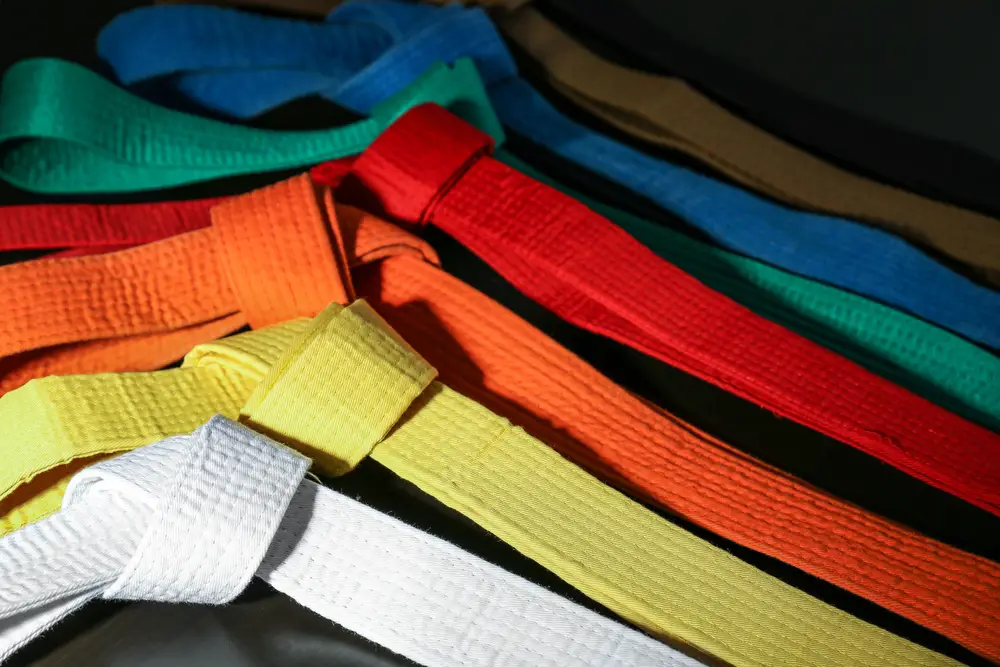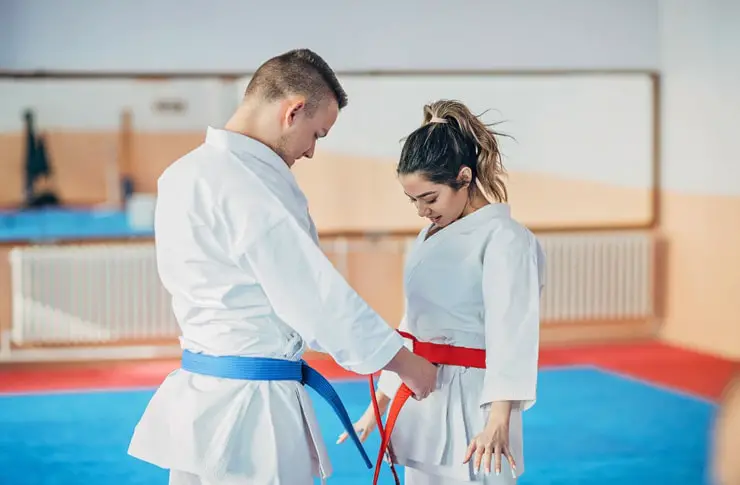
Taekwondo, as is the case with almost any martial art, uses a “belt” system to mark progress. Students begin with a white belt and eventually progress to a yellow belt, a green belt, a blue belt, a red belt, and a black belt. These taekwondo belts -which can also include a black stripe or a brown belt – are given to pupils who have demonstrated the necessary skill to claim the next colored belt.
In this article, we’re shifting our focus from the principles of taekwondo to the actual martial arts belt itself. We’re starting with our top beginner tip – how to tie your belt. Then, we’ll give you some background info on taekwondo belts and the various related customs and traditions.
How to Tie a Tae Kwon Do Belt
Tying a taekwondo belt isn’t necessarily difficult. However, you want to be sure that you do it the right way. Simply put, nothing will make you look like an amateur quite like an improperly tied belt. Luckily, this problem is very easy to avoid. Just follow this process to tie your belt correctly:
Step 1 – Center: First, hold your belt straight in front of you with both hands, with the tape side of the belt falling to your right side. Find the center of the belt and place it over your bellybutton. You will know the center because both sides of the belt will fall equal distance to the floor from both hands. When you are standing and holding the belt across your front, hold this position and move into Step 2.
Step 2 – Wrap: Wrap both sides of the belt around your back. It is important that you wrap it around your back while placing one side of the belt directly underneath the other side. Essentially, you are laying one side of the belt on top of the other as it crosses your back. Bring both sides around your back and hold the belt in front of you.
Step 3 – Tie: Now that the belt is wrapped around your waist, it is time to tie it. The knot is tied on the front side of your body, over your bellybutton. Grasp both sides of the belt and ensure one side is facing upward while the other is downward toward the floor.

Step 4 – Knot: Take the side of the belt that is facing down and fold it across the front of your body so that the frontside of the belt is facing you. Then, take the upward-facing side of the belt and fold it down across the front of the bottom piece. Once you see that a hole hasbeen created, take the top piece and pull it through the hole to create the knot. Then, both sides of the belt will fall, each facing forward, completing your taekwondo belt.
If your a visual learner check out this great video.
Note: Customs May Differ – Although this is one of the most common ways to tie a taekwondo belt, it is important to note that customs may differ depending on where you are practicing and your school’s customs and traditions. This is especially true when tying a black belt. Often, a black belt will utilize a “double wrap” technique, as opposed to the single wrap that we covered above. This being said, by the time you ascend from a white belt and reach your black belt, you will no doubt be an expert in tying a taekwondo belt, and a guide like this will not be relevant!
Belt Tightness – The Thumb Method
Even if you tie your taekwondo belt correctly, there is still potential to wrap the belt either too tight or too loose. As a general rule, you should be able to place one thumb under your belt freely, and also be able to comfortably wiggle the thumb. This allows enough space, so the belt is not uncomfortably tight while also ensuring it is snug enough to stay secure throughout your taekwondo training.
Important Custom – Respect
As noted above, taekwondo is a sport that is heavy on tradition. As a result, you need to pay close attention to the traditions and customs that are respected in your taekwondo school as they relate to tying your belt. Certain schools have strict regulations that require you to turn away from others when tying your belt. This is often most important when facing a practitioner of a higher rank, especially when it is an instructor. It may even be important to turn in the opposite direction when retying, or even when adjusting your belt.
Schools will be more or less strict when abiding by these traditions, which is why it’s most important to pay close attention to your own school’s rules and regulations. If you’re new to the school, it might be best just to ask someone.
And that does it for our beginner’s guide to taekwondo belts. Belts are an important mark of progression in taekwondo, and earning a new belt is always a satisfying experience. Good luck in your pursuit of that next belt!
